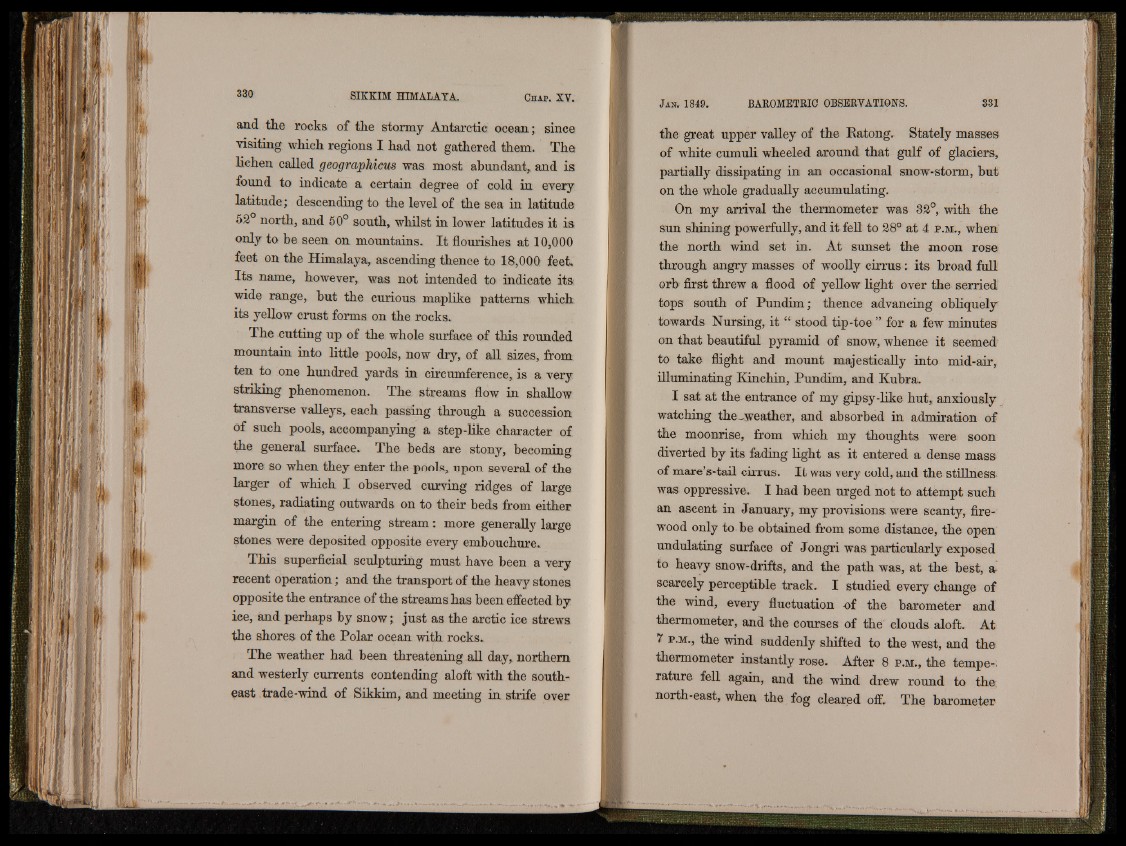
and the rocks of the stormy Antarctic ocean; since
visiting which regions I had not gathered them. The
lichen called geographicus was most abundant* and is
found to indicate a certain degree of cold in every
latitude; descending to the level of the sea in latitude
52° north, and 50° south, whilst in lower latitudes it is
only to be seen on mountains. I t flourishes at 10,000
feet on the Himalaya, ascending thence to 18,000 feet.
Its name, however, was not intended to indicate its
wide range, hut the curious maplike patterns which
its yellow crust forms on the rocks.
The cutting up of the whole surface of this rounded
mountain into little pools, now dry, of all sizes, from
ten to one hundred yards in circumference, is a very
striking phenomenon. The streams flow in shallow
transverse valleys, each passing through a succession
of such pools, accompanying a step-like character of
the general surface. The beds are stony, becoming
more so when they enter the pools, upon several of the
larger of which I observed curving ridges of large
stones, radiating outwards on to their beds from either
margin of the entering stream: more generally large
stones were deposited opposite every embouchure.
This superficial sculpturing must have been a very
recent operation; and the transport of the heavy stones
opposite the entrance of the streams has been effected by
ice, and perhaps by snow; just as the arctic ice strews
the shores of the Polar ocean with rocks.
The weather had been threatening all day, northern
and westerly currents contending aloft with the southeast
trade-wind of Sikkim, and meeting in strife over
the great upper valley of the Katong. Stately masses
of white cumuli wheeled around that gulf of glaciers,
partially dissipating in an occasional snow-storm, but
on the whole gradually accumulating.
On my arrival the thermometer was 32°, with the
sun shining powerfully, and it fell to 28° at 4 p .m ., when
the north wind set in. At sunset the moon rose
through angry masses of woolly cirrus: its broad full
orb first threw a flood of yellow light over the serried
tops south of Pundim; thence advancing obliquely
towards Nursing, it “ stood tip-toe ” for a few minutes
on that beautiful pyramid of snow, whence it seemed
to take flight and mount majestically into mid-air,
illuminating Kinchin, Pundim, and Kubra.
I sat at the entrance of my gipsy-like hut, anxiously
watching the ^weather, and absorbed in admiration of
the moonrise, from which my thoughts were soon
diverted by its fading light as it entered a dense mass
of mare’s-tail cirrus. I t was very cold, and the stillness
was oppressive. I had been urged not to attempt such
an ascent in January, my provisions were scanty, firewood
only to be obtained from some distance, the open
undulating surface of Jongri was particularly exposed
to heavy snow-drifts, and the path was, at the best, a
scarcely perceptible track, I studied every change of
the wind, every fluctuation of the barometer and
thermometer, and the courses of the clouds aloft. At
7 p .m ., the wind suddenly shifted to the west, and the
thermometer instantly rose. After 8 p .m ., the temperature
fell again, and the wind drew round to the:
north-east, when the fog cleared off. The barometer